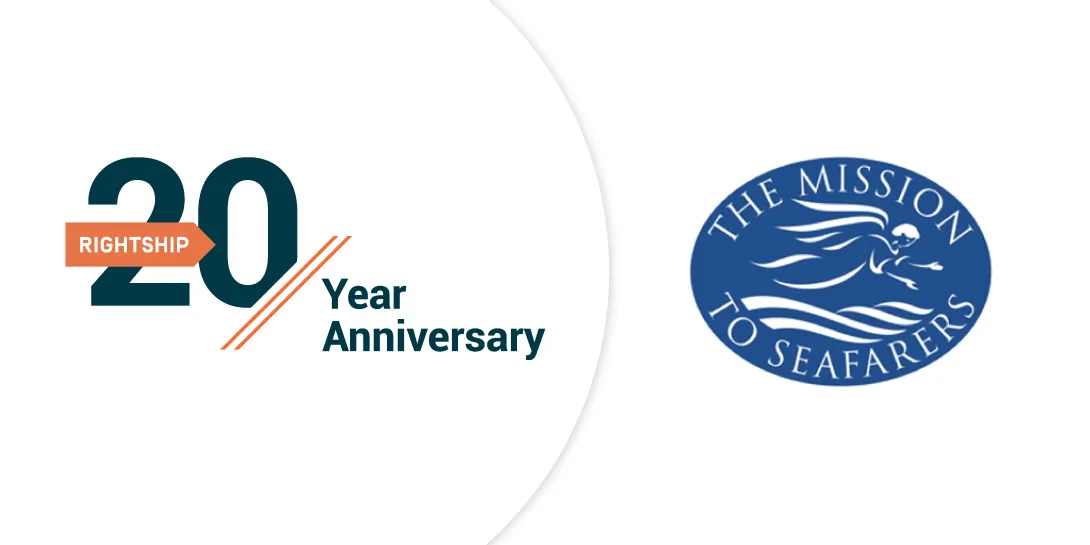As part of our 20-year celebrations, we’ve made a $20,000 USD unrestricted donation to the Mission to Seafarers. In this Q&A, the Mission’s Secretary General, Reverend Canon Andrew Wright, reflects on our relationship and the difference that charitable donations make to our seafarers.
Q: We’re pleased to be making a contribution to the Mission to Seafarers as part of our 20-year celebrations. Would you like to reflect on how it came about?
A: First, thank you to RightShip for this very generous donation, which comes on top of donations earlier this year. Your support helps us continue to support seafarers and their families around the world. Our relationship goes back quite a long way, from the time when, RightShip initially supported the Melbourne Mission to Seafarers.
Importantly, RightShip has done more than just make donations. You have also been advisors and collaborators, as well as physically supported us for events, including at the Melbourne Centre.
Q: Can you tell us a bit about how you distribute unrestricted funds to make a difference in the lives of seafarers
A: Unrestricted donations are vital. We have a huge portfolio of global work, with our port network and growing elements of wider programme. Some of our donations are tied to particular projects, which is great but can leave important gaps. Unrestricted donations give us a very important freedom and we are grateful for the particular trust placed in us in relation to such gifts, trust which we take very seriously.
Our port network reaches around 200m ports in 50 countries, with 29 in Australia, the birthplace of Rightship. Key activities include hospitality centres, transport ship visitation and emergency intervention programs.
Q: How hard is it to do this essential work as Covid continues to present challenges around the world?
A: During Covid it has been different. The crew change crisis in particular has made life acutely difficult and stressful for seafarers, placing additional responsibility on our teams. The cancellation of shore leave has also meant we cannot deliver our services in the normal way. The focus has been on ship visitation at the gangway, in a safe and distanced way, on personal shopping delivery (including of medical supplies), on the provision of MiFi units to help with communication and on emergency response.
Another key focus has been on the development of our digital services as we seek to maximise our support for seafarers in very unusual circumstances. Our Family Support Networks have also played a vital role.
Q: At RightShip we are optimistic about improving seafarer welfare in the next 20 years. But there are still immediate challenges, can you talk about some of these and what can be done to overcome them?
A: Progress continues to be made in large sections of the shipping industry. We applaud many exciting initiatives taken by so many over these last 18 months in terms of seafarer welfare. Many individuals and companies have really gone the extra mile. Mental health has really been a focus. Of course, the failure of so many governments to recognise seafarers as essential workers remains a scandal and a major hurdle. The situation for many seafarers remains very difficult – as it does for their families. In the darker side of the industry there stubbornly remain particular issues, not least the scourge of abandonment (and cases of grown in number over these last months).
In practical terms, universal, quality free Wi-fi access on board ship is a priority. To be out of touch with your family and not able to go ashore, is distressing. I applaud many companies who’ve done great work on that, but there are still many vessels without that access.
Finally, seafarer resilience is an immediate priority. Their lives are hard enough. Seafarers need support in looking after their mental health and that of their colleagues. Knowing when people are very low and being able to support - that’s come to the fore.
Q: In an ideal world, what would life at sea look like for seafarers 20 years from now?
A: We’re moving into a time of significant change, but it’s going to take a long time to get to full automation. We’ll see changes in the size of crews, they’ll get smaller and we will need to adapt. I would hope in 20 years seafarer wellbeing remains absolutely paramount and is a driving factor in the way the industry behaves.
We would like to see a situation where there is increasing government funding. For example, the New Zealand government has committed to substantial funding of the welfare organisations. That’s a positive and helpful partnership.
Importantly, we need to stamp out the key negatives including illegal crewing agencies taking sums of money from seafarers and placing them in debt, abandonment and failure to pay wages. Where standards are universal, poor and corrupt circumstances will cease. But the first step needs to be essential worker status.
One of the great things for me is the importance of our partnerships, including us with RightShip. It will take all of us working together to achieve that common vision.
Learn more about the Mission to Seafarers
